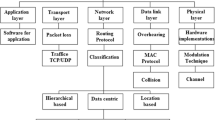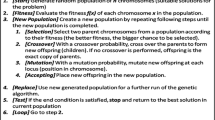Abstract
The core objective behind this research paper is to implement a hybrid optimization technique along with proactive routing algorithm to enhance the network lifetime of wireless sensor networks (WSN). The combination of two soft computing techniques viz. genetic algorithm (GA) and bacteria foraging optimization (BFO) techniques are applied individually on destination sequence distance vector (DSDV) routing protocol and after that the hybridization of GA and BFO is applied on the same routing protocol. The various simulation parameters used in the research are: throughput, end to end delay, congestion, packet delivery ratio, bit error rate and routing overhead. The bits are processed at a data rate of 512 bytes/s. The packet size for data transmission is 100 bytes. The data transmission time taken by the packets is 200 s i.e. the simulation time for each simulation scenario. Network is composed of 60 nodes. Simulation results clearly demonstrates that the hybrid approach along with DSDV outperforms over ordinary DSDV routing protocol and it is best suitable under smaller size of WSN.





Similar content being viewed by others
References
Haenggi, M. (2005). Chapter 1: Opportunities and challenges in wireless sensor networks. In M. Ilyas & I. Mahgoub (Eds.), Handbook of sensor networks: Compact wireless and wired sensing systems (pp. 1–11). Boca Raton: CRC Press.
Chong, C. Y., & Kumar, S. P. (2003). Sensor networks: Evolution opportunities, and challenges. Proceedings of IEEE,91(8), 1247–1256.
Akyildiz, I., Su, W., Sankarasubramaniam, Y., & Cayirci, E. (2002). A survey on sensor networks. IEEE Communications Magazine,40, 102–114.
Akkaya, K., & Younis, M. (2005). A survey on routing protocols for wireless sensor networks. Elsevier Ad Hoc Networks,3, 325–349.
Huang, C.-J., Wang, Y.-W., Liao, H.-H., Lin, C.-F., Hu, K.-W., & Chang, T.-Y. (2011). A power efficient routing protocol for underwater wireless sensor networks. Applied Soft Computing,11, 2348–2355.
Rani, S., Malhotra, J., & Talwar, R. (2013). EEICCP—Energy efficient protocol for wireless sensor networks. Wireless Sensor Network,5(7), 127–136.
Selvakennedy, S., Sinnappan, S., & Shang, Y. (2007). A biologically-inspired clustering protocol for wireless sensor networks. Computer Communications,30(14–15), 2786–2801.
Bara’a, A. A., & Khalil, E. A. (2012). A new evolutionary based routing protocol for clustered heterogeneous wireless sensor networks. Applied Soft Computing,12(7), 1950–1957.
Majhi, R., Panda, G., Majhi, B., & Sahoo, G. (2009). Efficient prediction of stock market indices using adaptive bacterial foraging optimization (ABFO) and BFO based techniques. Expert Systems with Applications,36(6), 10097–10104.
Tripathi, K., Agarwal, T., & Dixit, S. D. (2010). Performance of DSDV protocol over sensor networks. International Journal of Next Generation Networks,2, 53–59.
Sengar, E. A., & Shrivastav, E. S. (2012). Performance evaluation of AODV and DSDV routing protocols for ad hoc networks. Global Journal of Computer Science and Technology Network, Web & Security,12(16), 1–7.
Kambayashi, Y. (2013). A review of routing protocols based on ant-like mobile agents. Algorithms,6(3), 442–456.
Ben-Othman, J., & Yahya, B. (2013). Energy efficient and QoS based routing protocol for wireless sensor networks. Journal of Parallel and Distributed Computing,70(8), 849–857.
Kenchannavar, H. H., Domanal, S. G., & Kulkarni, U. P. (2013). Context-aware information processing in visual sensor network. In V. V. Das & Y. Chaba (Eds.), Mobile communication and power engineering (pp. 155–162). Berlin: Springer.
Harizan, S., & Kuila, P. (2019). Coverage and connectivity aware energy efficient scheduling in target based wireless sensor networks: An improved genetic algorithm based approach. Wireless Networks,25(4), 1995–2011.
Baroudi, U., Bin-Yahya, M., Alshammari, M., & Yaqoub, U. (2019). Ticket-based QoS routing optimization using genetic algorithm for WSN applications in smart grid. Journal of Ambient Intelligence and Humanized Computing,10(4), 1325–1338.
Yuan, X., Elhoseny, M., El-Minir, H. K., & Riad, A. M. (2017). A genetic algorithm-based, dynamic clustering method towards improved WSN longevity. Journal of Network and Systems Management,25(1), 21–46.
Elhoseny, M., Tharwat, A., Farouk, A., & Hassanien, A. E. (2017). K-coverage model based on genetic algorithm to extend WSN lifetime. IEEE Sensors Letters,1(4), 1–4.
Jha, S. K., & Eyong, E. M. (2018). An energy optimization in wireless sensor networks by using genetic algorithm. Telecommunication Systems,67(1), 113–121.
Acknowledgements
The authors would like to express their sincere thanks to Prof. Dr. Truong Khang Nguyen, Division of Computational Physics, Institute for Computational Science, Ton Duc Thang University, Ho Chi Minh City, Vietnam for giving his value suggestion, comments and support to complete this work as effective.
Author information
Authors and Affiliations
Corresponding author
Additional information
Publisher's Note
Springer Nature remains neutral with regard to jurisdictional claims in published maps and institutional affiliations.
Rights and permissions
About this article
Cite this article
Rani, S., Balasaraswathi, M., Reddy, P.C.S. et al. A hybrid approach for the optimization of quality of service metrics of WSN. Wireless Netw 26, 621–638 (2020). https://doi.org/10.1007/s11276-019-02170-9
Published:
Issue Date:
DOI: https://doi.org/10.1007/s11276-019-02170-9




